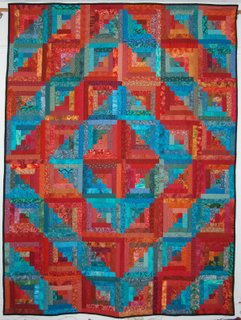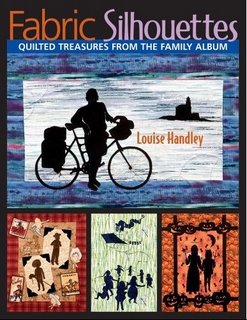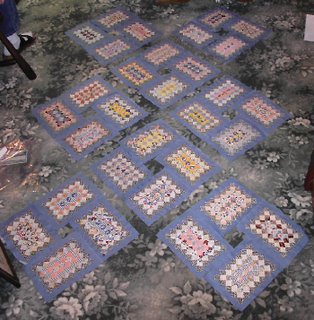
First of all, some elaboration on the last post. As the letter says, the Rocky Mountain Quilt Museum, in Golden, Colorado, has accepted Log Cabin, which is the one I had in the guild show a few months ago, for an exhibit. It will be shown from August 15 to October 21. This is a coup, probably more of a coup than the quilt really deserves, but I am completely stoked about it nonetheless.
I hadn't really expected it to be accepted. The RMQM has a show of quilts by men every two years, and that was my real target. I thought that if I submitted a piece now, they would know my name when the men's show came around. As it is, I wonder if the esoteric category of the show I was accepted for -- quilts using the color orange -- might have made it a "soft" field of entries.
So, I stuck Log Cabin in a box and mailed it to Colorado on Thursday. Even now, I'm afraid they'll say "sorry, dude, it looked better in the photo than in real life, we're not going to show it." But I hope not. My in-laws live in Colorado, and being shown in an honest-to-God museum has won major points with them, or at least helped to legitimize the whole boy-quilter thing.
Anyway, its good that Log Cabin is doing well, because it turns out that it is the perfect embodyment of the Michael Handley aesthetic. And I can prove it.
A couple weekends ago, I drove down to Sisters, Oregon, for their annual outdoor quilt show. The largest outdoor quilt show in the world, we're told, and it's not hard to believe -- pretty much every exterior surface of that oh-so-faux little village gets covered with quilts for one hopefully dry day every year, and the town turns into a packed madhouse of, well, the kinds of people who get excited about quilts. Such as myself.
There is no particular organizing principle to the layout of the quilts that I could detect, and with 1500 or so quilts to see and no one to talk about them with, I was initially a little puzzled on how to proceed. After fifteen minutes or so of checking out the scene, though, it occured to me that I had the opportunity to conduct an unusual experiment on myself. I could use the show to explore my own tastes, and find out if there are any specific kinds of quilts that I particularly respond to.
I used a highly sophisticated methodology for this experiment: I took pictures of quilts I liked. Which is to say, I walked around the town, taking a brief glance at nearly all of the pieces on display, and without further thinking took pictures of the ones I was immediately attracted to. I tried to surpress any thinking about craftsmanship, tradition, innovation, symbolism, or anything else beyond an immediate gut reaction. I didn't note who the quiltmaker was, and I didn't make any attempt to get a good picture -- just a quick snapshot of every quilt that jumped out at me.
I ended up taking 75 pictures, meaning -- if we stipulate that the Sisters show represented a reasonable cross section of quilting as a whole -- that about 5% of quilts jump out at me. Through the miracle of modern uploading, I have placed the entire collection online at http://pg.photos.yahoo.com/ph/drhandley/my_photos, where you are welcome to take a look if you so desire.
So, is there some kind of pattern to the quilts I like? Oh mai oui. Embarassingly so, as it turns out.
Of the 75 quilts I liked, it turns out that 68 of them are geometric -- i.e. composed of rectangles, triangles, circles, diamonds, and occasionally hexagons or octogons. (19 of them, in fact, are composed only of squares and rectangles).
Now, this is interesting to me, because most of my own pieces are also geometric. I have always had the nagging fear that I worked in geometries because it is easier than the piecing or applique techniques involved in working with non-geometric shapes (although that isn't necessarily true), or because I am too lazy to learn new techniques. But, having done this experiment, I'm thinking I might stick with geometries for the more defensible reason that those the kinds of quilts I like. It doesn't seem like it should be a startling revelation, but it kind of is.
A whopping 62 of the 75 are not only geometric, but also symetrical, laterally or vertically, or both. (I designated five more are "semi-symetrical," whatever that means.) I guess I like orderliness in my geometrical patterns.
How about color? Well, it would seem I like vivid, saturated colors -- 43 of the quilts I liked use brilliant "jewel tones" in their coposition. And another 43 -- quite a bit of overlap here, obviously -- used patterns based primarily on contrasting color values. Here, again, what I like seems awfully similar to what I do. More than half of my quilts are patterned on value contrasts, and yeah, I'm a notorious jewel-tone junky.
Log Cabin is made exclusively of rectangles -- 768 of 'em -- so it's nothing if not geometrical. It's laid out in a tightly symetrical pattern. In earlier posts, we've talked about it's refusal to involve a value contrast, but it certainly cranks up the brilliant saturated colors. According to my experiment, it is exactly the kind of quilt I like. So, it seems appropriate that it is my flagship piece for the moment.
It's nice to know what I like. Now I can go make more.


 In the early 1930s, Mary Sampson, the grandmother of my grandmother's cousin, had such severe arthritis that she could no longer comfortably hold the weight of a full quilt top. An lifelong quilter, now in her late 80s, she continued to make individual blocks. Lots of individual blocks. Made of one-inch squares, following a kind of "Around the World" pattern, and sewn by hand with needle and thread with tremendous craftsmanship, these little quilts are works of art in themselves (we have some mounted behind glass hanging in our living room). They are also testament to the time on one woman's arthritic hands -- by the time of her death in 1934, there were hundreds upon hundreds of these blocks. All of a pattern, and unified by the black and white fabric of their outer rings, they appear to have been intended for a single project. Sampson, however, had made three or four times as many blocks as would have been needed for even the largest imaginable quilt.
In the early 1930s, Mary Sampson, the grandmother of my grandmother's cousin, had such severe arthritis that she could no longer comfortably hold the weight of a full quilt top. An lifelong quilter, now in her late 80s, she continued to make individual blocks. Lots of individual blocks. Made of one-inch squares, following a kind of "Around the World" pattern, and sewn by hand with needle and thread with tremendous craftsmanship, these little quilts are works of art in themselves (we have some mounted behind glass hanging in our living room). They are also testament to the time on one woman's arthritic hands -- by the time of her death in 1934, there were hundreds upon hundreds of these blocks. All of a pattern, and unified by the black and white fabric of their outer rings, they appear to have been intended for a single project. Sampson, however, had made three or four times as many blocks as would have been needed for even the largest imaginable quilt.
